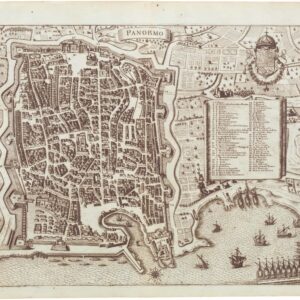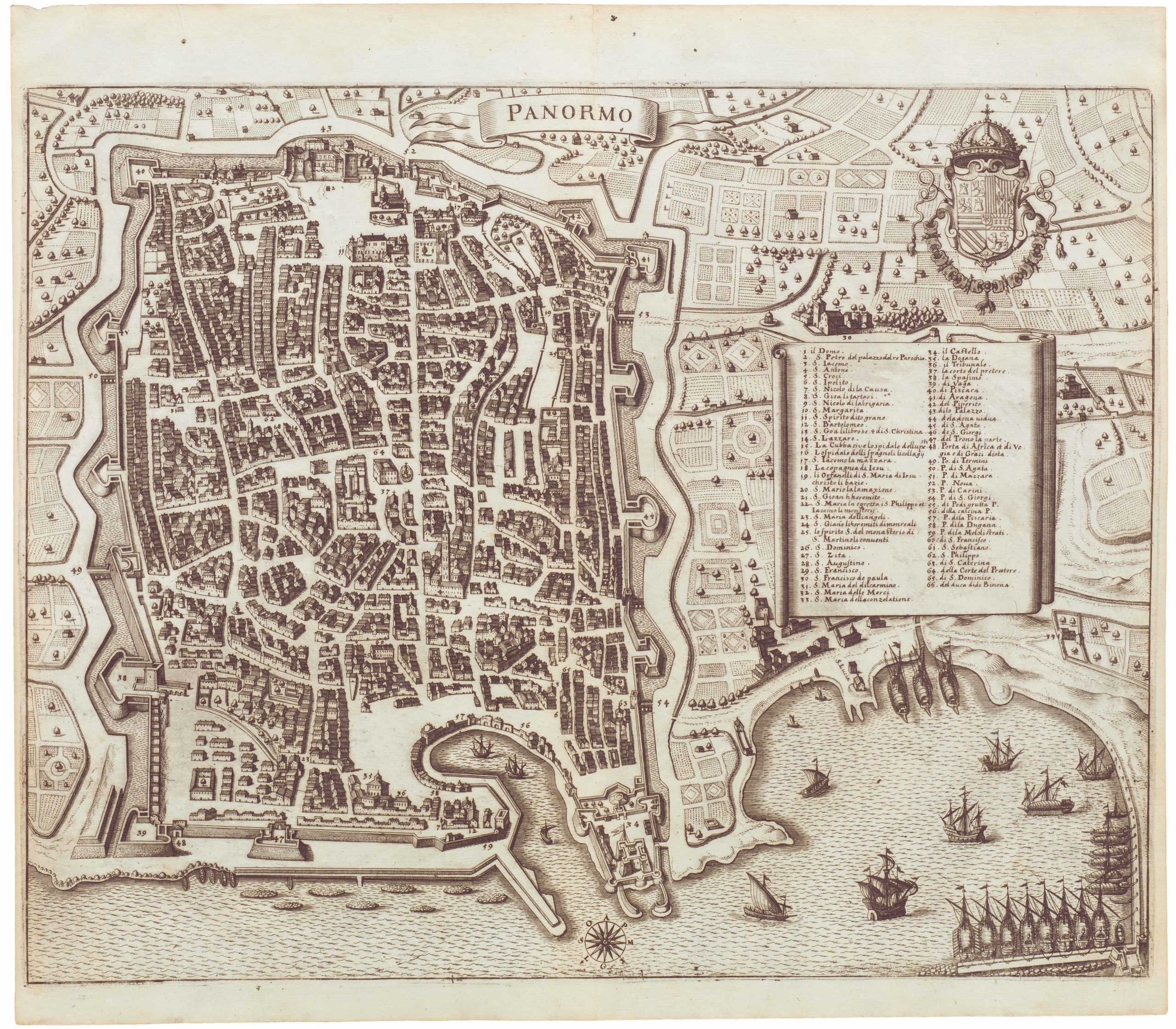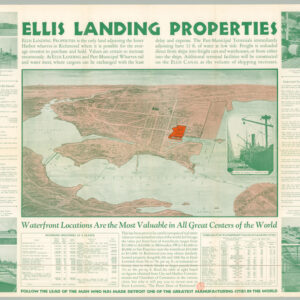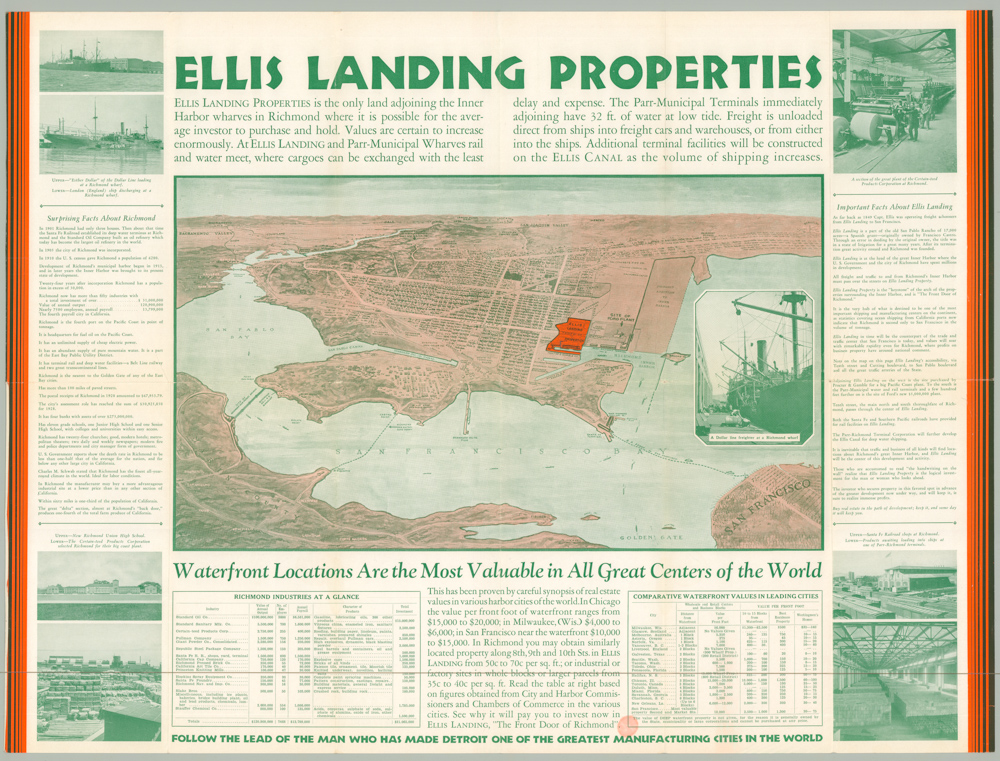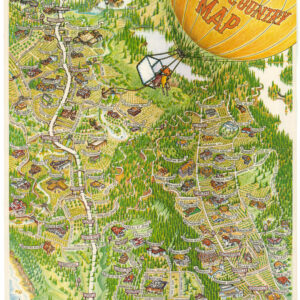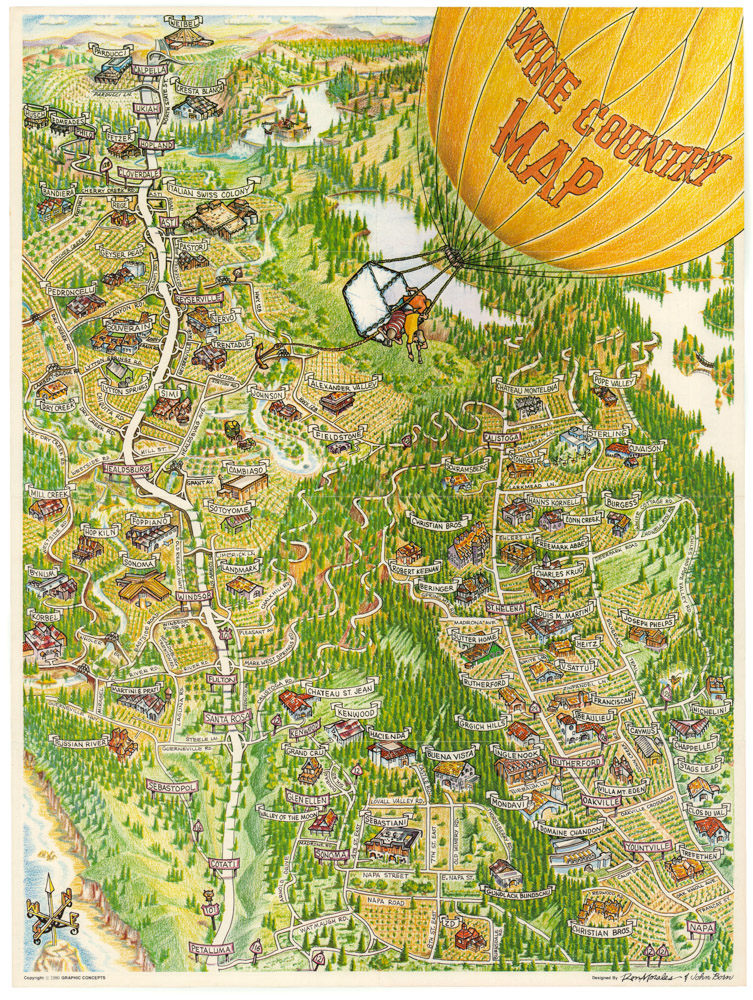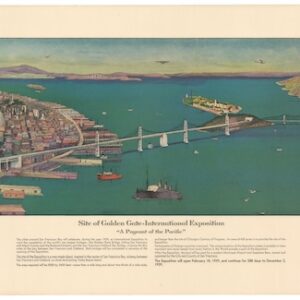Early view of the U.S. Navy Yard at Mare Island, with Marin and Mount Tamalpais in the background.
U.S. Navy Yard. At Mare Island, California.
$4,500
1 in stock
Description
This superb bi-chrome lithograph of the U.S. Naval Yard at Mare Island was issued by the famous San Francisco printing duo of Britton & Rey some seven years into the Gold Rush.
When California formally became part of the United States in 1848, following the Treaty of Guadalupe Hidalgo, the United States Navy sought to secure control of the region by establishing a new naval base on the Pacific seaboard. The location selected for this purpose lay 25 miles northeast of San Francisco, in what today is known as Vallejo. Here, the estuary of the Napa River created a large wetlands area that was shielded behind an enormous embankment known as Mare Island.
Following years of extensive surveys in the early 1850s, Mare Island was chosen as the best location for the base. Construction of the facilities at Mare Island started in early 1853. Concurrent with this development, the enormous land grant of General Mariano Guadelupe Vallejo, known locally as the Rancho Suscol, was selected for the establishment of a new town intended to serve as the new state capital. The town of Vallejo would only enjoy this status for a few years (1852-53) before yielding it to Sacramento.
The Mare Island Naval Base was built on a large sandbank that ran parallel to the actual mainland and shielded the wetland estuary from the Bay’s open waters. It was an ideal location for any large fleet. Because Mare Island became the first official base of operations for the Pacific Fleet, it was both a prominent and essential project, and the base grew in tandem with Vallejo. From the town, citizens could watch the many activities of the base and see a range of military and other vessels docking at the long quay.
Britton & Rey’s print was issued in 1856, only some three years after the land was purchased and construction of the base had begun. The perspective is drawn from the slowly developing town of Vallejo, and looks across the harbor onto the Naval Yard on Mare Island. Little is known about the exact layout and appearance of the Naval Yard during these initial years, which is part of what makes this print so exciting. The view depicts a considerable number of buildings along the waterfront, some of which are relatively monumental.
Among the specifics we know about Mare Island’s early history is that shipbuilding operations commenced on 16 September 1854 under the supervision of Navy Commander David Farragut. Farragut would win great renown in the Civil War’s Battle of Mobile Bay, during which he famously ordered: “Damn the torpedoes, full speed ahead!“. We shall return to Commander Farragut shortly, but in 1853 none of this was yet on the horizon. The U.S. naval presence on the West Coast and in the Pacific needed to be cemented, and Farragut was the man who would build the fleet to accomplish it.
The view shows limited occupation along the water on the Vallejo side. We see a few rooftops of building units closer to the water and a farm in the foreground. Other than these structures, the only evidence for prolonged settlement consists of a fenced area, most likely for livestock, as suggested by the artistic inclusion of cows and their herders in the lower right corner of the image. Beyond this, we see the naval base fronted by the narrow strait that separates it from Vallejo. The island has multiple large buildings, and a flurry of ships and boats occupy both the great quay and the surrounding waters.
Among the buildings we have identified are the Marine Barracks, the solitary building on the right fringe of the image. An 1861 sketch confirms that the large central building was the ‘Smithery’ for working steel for hull construction. The huge chimney confirms this attribution.
USS Independence and the new dry dock
Further to the left, we see a massive wooden frame around large sailing ship, representing the newly built dry docks. Like the smithery, these repair and construction facilities were crucial if the Mare Island Naval Yard was to sustain the Pacific fleet. The ship depicted inside these new facilities is the navy frigate USS Independence, which tested the dry-dock in December 1855. The inclusion of this key event allows us to date the lithograph so firmly to 1856.
We can identify this “wrapped” ship with such certainty because a second state of this iconic print exists in which the following information has been added in print below the main title: “Capt. D. G. Farragut Commanding. Showing the works already completed in the Navy yard, and the U. S. Frigate Independence as she appeared upon the U. S. Dry Dock in its trial test of Dec. 10th and 11th, 1855.” An example of this state exists in the Stanford Library (identifier rd-189).
A wide variety of ships
The bustle of the scene provides a (presumably unintentional) window into how quickly maritime technology and trade were changing in the mid-19th century. Many different vessel types are depicted in the harbor. Among them, large sailing ships stand out, in part due to their imposing masts. We have already noted the presence of a U.S. Navy frigate. The other multi-masted vessel appears to be one of the famous Clippers that sailed on San Francisco in the mid-19th century. Clippers were long and slender merchant vessels that had been (re-)designed to prioritize speed above capacity. While their days of dominating maritime trade along the West Coast were ending, during the early years of the Mare Island shipyards, repairing clipper ships constituted an essential part of the base’s economy.
In addition to wind-powered ships, we also note several steam-powered vessels in the harbor. These herald the new technologies that soon would make clippers and other commercial or military sailboats a thing of the past. Interspersed among the larger craft are rowboats, schooners, yachts, and a steam-driven paddle ferry transporting a passenger to and from Vallejo. And finally, we note in the distance the Golden Gate and the majestic peak of Mount Tamalpais in Marin County, completing this iconic California view.
Despite the focus on shipbuilding and repair, only a single new ship was built at Mare Island prior to the beginning of the Civil War. The USS Saginaw (originally named the Toucey) was a wooden side-wheel sloop-of-war completed in 1858 and launched the following year. It served throughout the Civil War, engaging in multiple skirmishes and battles, but sank in 1870 when it struck a Pacific atoll.
Historical legacy of Mare Island
During the Civil War, Mare Island constituted the most important base of operations on the West Coast. While it was not in California that the most violent confrontations of that conflict took place, the naval yard played a decisive role in civil defense and sustaining U.S. naval power over the Pacific. Among the yard’s formal activities during the war was the dispatch of the USS Wyoming to the Panama Canal to safeguard America’s commercial interests. Warships were also sent from Mare Island to the Pacific Northwest to subdue ‘unrest’ among the indigenous peoples.
From the First World War on, Mare Island became the most crucial port facility on the Pacific – especially regarding submarines. It also maintained this role in the Second World War, becoming a crucial node for rebuilding the Pacific fleet following the Japanese attack on Pearl Harbor. Mare Island Naval Yard was declared a California Historic Landmark in 1960 and a National Historic Landmark in 1975. Despite its longstanding purpose, the naval base was finally closed in 1996.
Cartographer(s):
Britton & Rey (1852 – 1906) was a lithographic printing firm based in San Francisco and founded by Joseph Britton and Jacques Joseph Rey in 1852. Especially during the second half of the 19th century, Britton and Rey became the leading lithography firm in San Francisco, and probably California. Among their many publications were birds-eye-views of Californian cities, depictions of the exquisite landscapes, stock certificates, and no least maps. While Rey was the primary artist, Britton worked not only as the main lithographer but was essentially also the man running the business. In addition to their own material, the firm reproduced the works of other American artists like Thomas Almond Ayres (1816 – 1858), George Holbrook Baker (1824 – 1906), Charles Christian Nahl (1818 – 1878), and Frederick August Wenderoth (1819 – 1884). Following Rey’s death in 1892 Britton passed the form on to Rey’s son, Valentine J. A. Rey, who ran it until the great earthquake and fire of 1906 destroyed most of the company’s assets.
Joseph Britton (1825 – July 18, 1901) was a lithographer and the co-founder of the prominent San Francisco lithography studio Britton and Rey. He was also a civic leader in San Francisco, serving on the Board of Supervisors and helping to draft a new city charter. In 1852, he became active in lithography and publishing, first under the name ‘Pollard and Britton,’ and then ‘Britton and Rey,’ a printing company founded with his friend and eventual brother-in-law Jacques Joseph Rey. Britton and Rey became the premier lithographic and engraving studio of the Gold Rush era, producing letter sheets, maps, and artistic prints.
Jacques Joseph Rey (1820 – 1892) was a French engraver and lithographer born in the Alsatian town of Bouxwiller. At the age of about 30, he emigrated to America, eventually settling in California. Here, he soon entered into a partnership with local entrepreneur and civic leader Joseph Britton. Three years later, Rey also married Britton’s sister, allowing his business partner and brother-in-law Britton to live in their house with them. Rey and Britton were not only an important part of the San Francisco printing and publishing scene but also owned a plumbing and gas-fitting firm. In the early years, both men would sometimes partner up with others on specific projects, but by the late 1860s, their partnership was more or less exclusive.
J.B. DunlapJ.B. Dunlap (1825-1864) was an American engraver and lithographer active in Northern California.
Condition Description
Minor scuffing in the margins, else excellent.
References
